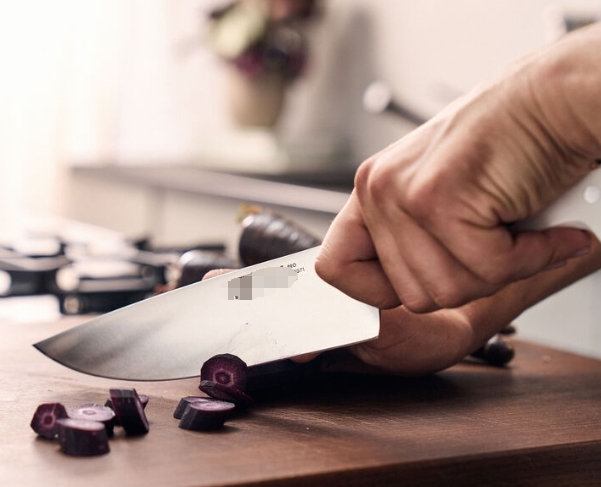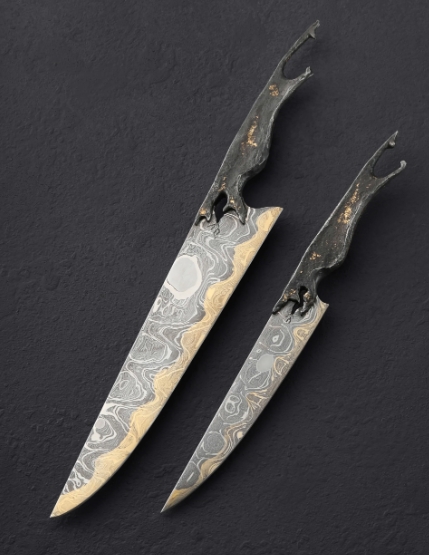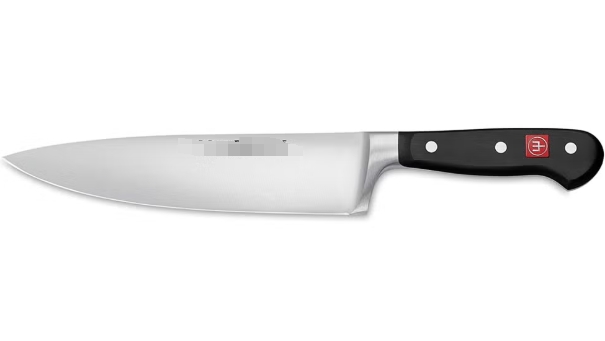

Views: 222 Author: Ella Publish Time: 2025-04-17 Origin: Site








Content Menu
● Chef Knife vs Utility Knife: Side-by-Side Comparison
● Which Knife Is More Versatile?
● Visual Guide: Chef Knife vs Utility Knife
● Tips for Choosing Between a Chef Knife and a Utility Knife
● Frequently Asked Questions (FAQ)
>> 1. What is the main difference between a chef knife and a utility knife?
>> 2. Can a utility knife replace a chef knife?
>> 3. Which knife is better for beginners?
>> 4. Are utility knives always serrated?
>> 5. How should I maintain my chef and utility knives?
When it comes to kitchen knives, two of the most commonly used types are the chef knife and the utility knife. Both knives serve important roles in food preparation, but they differ significantly in size, design, and functionality. Understanding these differences will help you choose the right knife for your cooking needs and unlock greater efficiency and precision in the kitchen.

A chef knife, also known as a cook's knife, is the quintessential all-purpose kitchen knife. It typically features a broad, curved blade ranging from 6 to 14 inches in length, with 8 inches being the most popular size. The blade's curve allows for a rocking motion that facilitates fast chopping, dicing, and slicing of medium to large ingredients.
Key Characteristics:
- Blade Length: 6 to 14 inches (commonly 8 inches)
- Blade Shape: Broad, curved with a sharp pointed tip
- Functionality: Ideal for chopping, slicing, dicing, mincing, and disjointing meat
- Design: Well-balanced and weighted for prolonged use and heavy-duty tasks
Uses of a Chef Knife:
- Chopping medium to large vegetables such as lettuce, cauliflower, and broccoli
- Slicing large cuts of meat and poultry
- Mincing herbs and nuts
- Dicing fruits and vegetables quickly
- Disjointing some cuts of meat
Limitations:
- Not ideal for very precise or delicate tasks such as peeling or mincing small items
- Not suitable for slicing bread or very hard vegetables like winter squash
- Can be bulky for cooks with smaller hands or for tasks requiring fine control
The utility knife is a versatile kitchen tool that bridges the gap between the chef knife and the paring knife. It usually has a blade length between 4 and 9 inches, with 5 to 7 inches being common. Utility knives may have straight or serrated edges and are designed for precision cutting where a chef knife might be too large and a paring knife too small.
Key Characteristics:
- Blade Length: 4 to 9 inches (commonly 5 to 7 inches)
- Blade Shape: Narrower and straighter than a chef knife; sometimes serrated
- Functionality: Suited for slicing smaller produce, sandwiches, and delicate meats
- Design: Lightweight and easy to maneuver for precision cuts
Uses of a Utility Knife:
- Slicing sandwiches, bread rolls, and bagels
- Cutting smaller vegetables and fruits like carrots, tomatoes, and apples
- Thinly slicing meats and poultry
- Peeling and trimming fruits and vegetables
- Slicing hard cheeses and cured meats
Limitations:
- Not effective for chopping large or dense vegetables and meats
- Serrated blades may struggle with hard or dense ingredients requiring force
- Does not excel in any one area but is a versatile “jack of all trades”

| Feature | Chef Knife | Utility Knife |
|---|---|---|
| Blade Length | 6 to 14 inches (usually 8") | 4 to 9 inches (usually 5-7") |
| Blade Shape | Broad, curved, pointed tip | Narrower, straighter, sometimes serrated |
| Primary Use | Chopping, slicing, dicing large to medium ingredients | Precision slicing of small to medium ingredients |
| Weight & Balance | Heavier, well-balanced for heavy-duty use | Lighter, easier to maneuver |
| Precision | Moderate precision, suited for larger cuts | High precision for delicate tasks |
| Ideal For | Vegetables, large cuts of meat, herbs | Sandwiches, small fruits, thin cuts of meat |
| Not Ideal For | Bread, peeling, very small tasks | Large vegetables, heavy chopping |
The answer depends on what you mean by versatility.
- Chef Knife: It is often considered the most versatile knife in the kitchen because it can handle a wide variety of tasks from chopping vegetables to slicing meat and mincing herbs. Its size and design make it indispensable for medium to large ingredients and heavy-duty prep work. For most home cooks and professional chefs alike, the chef knife is the go-to all-purpose tool.
- Utility Knife: While it may not be as powerful as a chef knife, the utility knife offers versatility in precision tasks where the chef knife might be too large or unwieldy. It excels at smaller, more delicate cuts and can replace both a paring knife and a small slicing knife in many cases. It is also handy for tasks like slicing sandwiches or trimming meat.
In summary: The chef knife is more versatile for general kitchen use, especially for larger ingredients and heavy chopping. The utility knife is more versatile for precision and smaller tasks, making it an excellent complement to the chef knife rather than a replacement.
- Consider the size of your hands and comfort: Smaller hands may prefer the lighter, smaller utility knife.
- Think about the types of food you prepare most often: If you frequently chop large vegetables or carve meat, a chef knife is essential.
- For precision tasks like slicing sandwiches, trimming fruit, or delicate cuts, a utility knife is ideal.
- Many cooks find having both knives in their kitchen provides the best versatility.
- Both knives should be hand-washed with mild detergent and dried immediately to maintain sharpness and prevent corrosion.
- Regular sharpening is essential to keep the blades effective.
- Avoid using knives on very hard surfaces or for cutting bones to prevent damage.
Both the chef knife and utility knife are indispensable tools in the kitchen, each offering unique advantages. The chef knife is the workhorse, capable of handling a broad range of tasks with efficiency and power. The utility knife shines in precision and smaller-scale cutting jobs. For most home cooks and professionals, owning both knives offers the greatest versatility and convenience.
Choosing between them depends on your cooking style, the types of ingredients you handle, and your preference for blade size and control. Investing in quality versions of both knives and maintaining them well will elevate your cooking experience and efficiency.

The main difference lies in size and function: chef knives have larger, broader blades (6-14 inches) designed for chopping and slicing medium to large ingredients, while utility knives have smaller blades (4-9 inches) suited for precision cutting of smaller items[1][3][8].
While a utility knife can handle many tasks, it cannot fully replace a chef knife due to its smaller size and lack of power for heavy chopping. It is best used as a complement for precision work[7][15].
Beginners often find utility knives easier to handle due to their smaller size and lighter weight, making them good for learning precision cuts. However, a chef knife is essential for general kitchen tasks[7][9].
No, utility knives come with both serrated and straight edges. Serrated blades are useful for cutting bread and tougher skins, while straight edges are better for clean slicing[1][8].
Hand wash knives with mild soap, dry immediately, and sharpen regularly. Avoid dishwashers and cutting on hard surfaces to prolong blade life[12][16].
[1] https://madeincookware.com/blogs/chef-knife-vs-utility-knife
[2] https://www.youtube.com/watch?v=0NaDJusUMgs
[3] https://www.webstaurantstore.com/guide/538/types-of-knives.html
[4] https://www.istockphoto.com/photos/chef-knife
[5] https://www.istockphoto.com/photos/utility-knife
[6] https://www.thebambooguy.com/blogs/kitchen-knives/frequently-asked-questions-about-kitchen-knives
[7] https://knivesetcetera.com/blogs/the-knife-chef/utility-knife-everything-you-need-to-know
[8] https://kuisinemall.com/blogs/news/utility-knife-vs-chef-knife-what-s-the-difference
[9] https://misen.com/blogs/news/types-of-kitchen-knives
[10] https://www.istockphoto.com/illustrations/chef-knife
[11] https://www.freepik.com/free-photos-vectors/utility-knife
[12] https://theknifestore.co.uk/pages/frequently-asked-questions-about-knives
[13] https://kamikoto.com/blogs/fundamentals/understanding-kitchen-knives-types
[14] https://unsplash.com/s/photos/chef-knife
[15] https://cooking.stackexchange.com/questions/28507/when-is-a-utility-knife-to-be-preferred-over-a-chefs-or-a-paring-knife
[16] https://elementknife.com/pages/common-questions-about-kitchen-knives
[17] https://yakushiknives.com/blogs/yakushi-blog-all-thing-knives/what-kitchen-knives-do-i-need-expert-recommendations
[18] https://www.pexels.com/search/kitchen%20knife/
[19] https://www.escoffier.edu/blog/culinary-arts/different-knives-and-the-best-uses-for-each/
[20] https://madeincookware.com/blogs/utility-knife
[21] https://www.freepik.com/free-photos-vectors/kitchen-knife
[22] https://www.youtube.com/watch?v=ZL6v_8E45xw
[23] https://www.seriouseats.com/the-best-essential-knives
[24] https://shun.kaiusa.com/blade-shapes
[25] https://www.escoffier.edu/blog/culinary-arts/different-knives-and-the-best-uses-for-each/
[26] https://www.nytimes.com/wirecutter/reviews/the-best-chefs-knife-for-most-cooks/
[27] https://www.insight-kitchenknife.comkitchen-knife-vs-chef-knife-what-s-the-real-difference.html
[28] https://www.blackmoorhome.co.uk/blog/a-guide-to-different-types-of-kitchen-knives/
[29] https://www.kuvings.com.au/the-complete-guide-to-knives/
[30] https://www.reddit.com/r/chefknives/comments/rwf7j2/question_for_you_knowledgeable_folks_6_chef_knife/
[31] https://vitals.lifehacker.com/best-kitchen-knives-to-buy-for-any-cooking-style-and-budget
[32] https://cooking.stackexchange.com/questions/28507/when-is-a-utility-knife-to-be-preferred-over-a-chefs-or-a-paring-knife
[33] https://stock.adobe.com/search?k=chef+knife
[34] https://www.youtube.com/watch?v=R_U6uYnWZic
[35] https://www.shutterstock.com/search/chefs-knife
[36] https://www.istockphoto.com/photos/utility-knife-safety
[37] https://www.youtube.com/watch?v=N46Bany7mus
[38] https://stock.adobe.com/search?k=%22chef%27s+knife%22
[39] https://www.shutterstock.com/search/retractable-blade-knife
[40] https://www.youtube.com/watch?v=0vUZXmroBfA
[41] https://www.shutterstock.com/search/utility-knife
[42] https://www.youtube.com/watch?v=hxIandWOBJ4
[43] https://stock.adobe.com/search/images?k=utility+knife
[44] https://www.youtube.com/watch?v=QgVyN6Lpiuc
[45] https://www.reddit.com/r/chefknives/comments/jbgamb/6_chefs_knife_vs_utility_knife/
[46] https://www.mercerculinary.com/preview/faqs/
[47] https://www.ikea.com/in/en/rooms/dining/knife-guide-choose-the-right-knife-for-your-kitchen-tasks-pub3cb4555b/
[48] https://germancut.de/en/blog/blog-chefs-knife-f-a-q-frequently-asked-questions-about-knives/
[49] https://www.zwilling.com/uk/magazine/product-guide-knives/knife-types.html
[50] https://www.tefal.com/instructions-for-use/Products-/Cookware/Kitchen-knives/csc/KitchenKnives
[51] https://stellaculinary.com/content/how-pick-out-chefs-knife-thats-right-you
[52] https://www.epicedge.com/shopcontent.asp?type=FAQ_ee
[53] https://artisanrevere.com/blogs/education/knife-faq-and-problem-solving